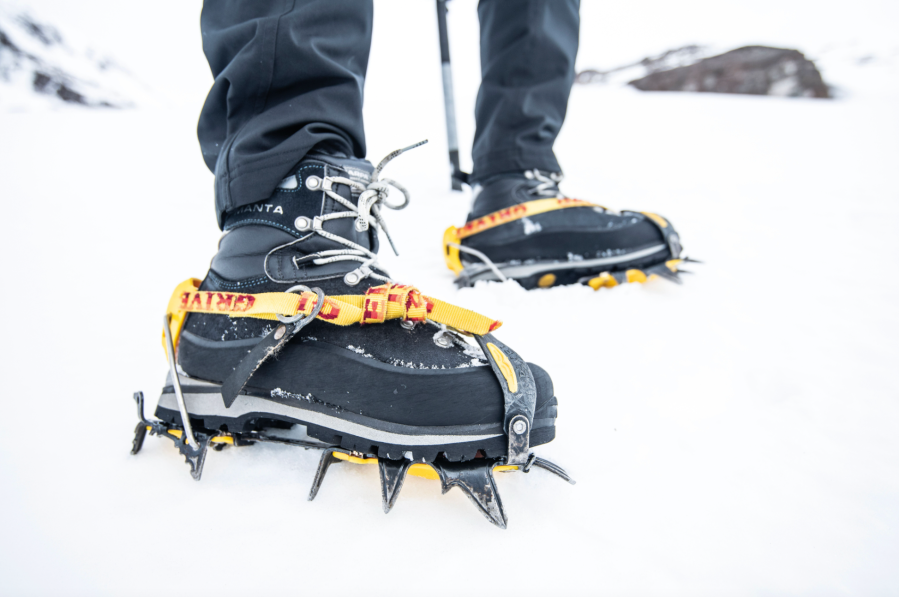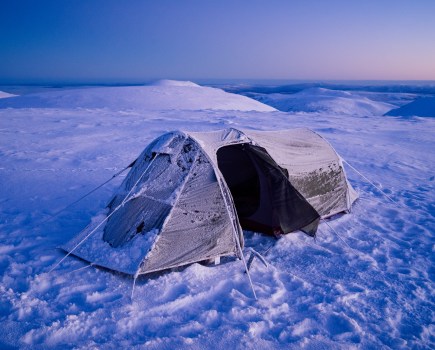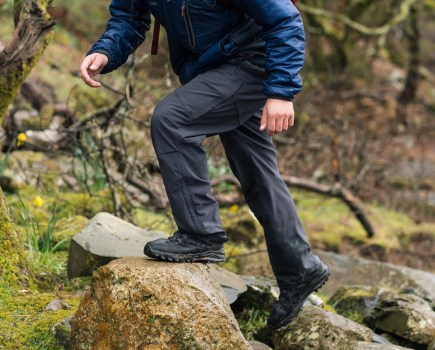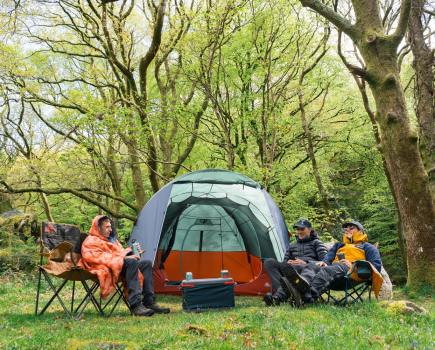For lowland rambles in winter, and hillwalking where no snow is present, ‘ordinary’ three season hillwalking footwear is just fine. But with the addition of snow and ice, hillwalking y blurs into mountaineering, requiring additional skills, clothing and equipment. The most (literally) fundamental of these is winter mountaineering boots.
Choosing winter mountaineering boots can be confusing. There’s a bewildering choice of materials, associated hardware and rating systems – and sometimes no rating system at all! Some of the boots in this review are dedicated winter walking boots. They are designed to perform on steep ground, snow and ice, abrasive rock, during hours of crampon use and in low temperatures. They will typically be very protective, stiff both in the sole and the upper, reliably waterproof and have good crampon compatibility. These are usually referred to as a B2 or a B3 boot and would be overkill for summer hillwalking.
Other boots in this review are perhaps better described as ‘4 season’ – they can be used comfortably all year round in the mountains, and with some adapting of techniques and careful crampon choice they should be equally at home in the winter hills. They will generally be more flexible for wearer comfort and will often come with either a B1 or B0 rating.
The ‘B rating’ number relates to stiffness, and a matching crampon rating. A C2 crampon should match a B2 boot well, but not a B1 – the crampon might be too stiff. B3 boots are exceptionally stiff, often used for high altitude or ice climbing, and as such fall outside our remit here.
So far, so good – but now it gets confusing. A B0 boot will not have been designed for crampon compatibility, but there are some lightweight crampons that should fit. Not all boots carry a B rating from the manufacturer – in which case, we’ve noted this in our reviews. What’s good to look for in all winter footwear, regardless of ratings? Generally, we’re after a durable upper. We want a more aggressive sole that will dig securely into snow, slush and mud. And yes, check crampon fit too – it’s a big added expense if your old crampons don’t fit your new mountaineering boots. But above all, try the boots on in the shop. Take your time and walk around in them and borrow a rucksack in the shop to get some weight on your feet. Fit is always the first and most important consideration.
Learn more about crampon compatibility and features to look for in the best winter mountaineering boots below.
The best winter mountaineering boots: tested
Testing conditions
Kirsty is a UK size 5/EU 38, with a wide forefoot. Most mountaineering boots were tested during the winter of 2022/23 on both personal mountaineering days and while delivering winter skills courses, in all weather and conditions. The latter often involves lots of standing still and digging, so the waterproofing and insulation properties were well tested! The AKU boots are a new model so haven’t been tested in snow, but were used in cold autumnal weather on steep and wet terrain. Boots were weighed on Kirsty’s digital scales.
Peter took these mountaineering boots on trips to the Arrochar Alps in winter conditions in early 2023 and has continued to wear them throughout the year in cool and wet conditions. Peter approaches winter footwear from a lightweight perspective and has adapted his techniques on winter ground and crampon choice accordingly. A variety of crampon styles were fitted to each boot. Boots were weighed on Peter’s digital scales.
Additional testing of winter mountaineering boots was conducted by Lucy Wallace and David Lintern in winter 2020/21.
- Mammut Kento Pro High | Kirsty’s Best Buy
- Meindl Vakuum Men GTX | Peter’s Best Buy
- Lowa Cevedale Evo GTX Ws | Lucy’s Best Buy in 2021
- Lowa Alpine Pro GTX | David’s Best Buy in 2021
- Scarpa Manta Tech
- Salewa Ortles Ascent Mid
- AKU Trekker Therm200
- Altberg Mallerstang Mountain Boot
- Hanwag Ferrata II GTX
- Keen Revel IV High Polar Boot
Best Buy in 2023: Mammut Kento Pro High (RRP: £290)
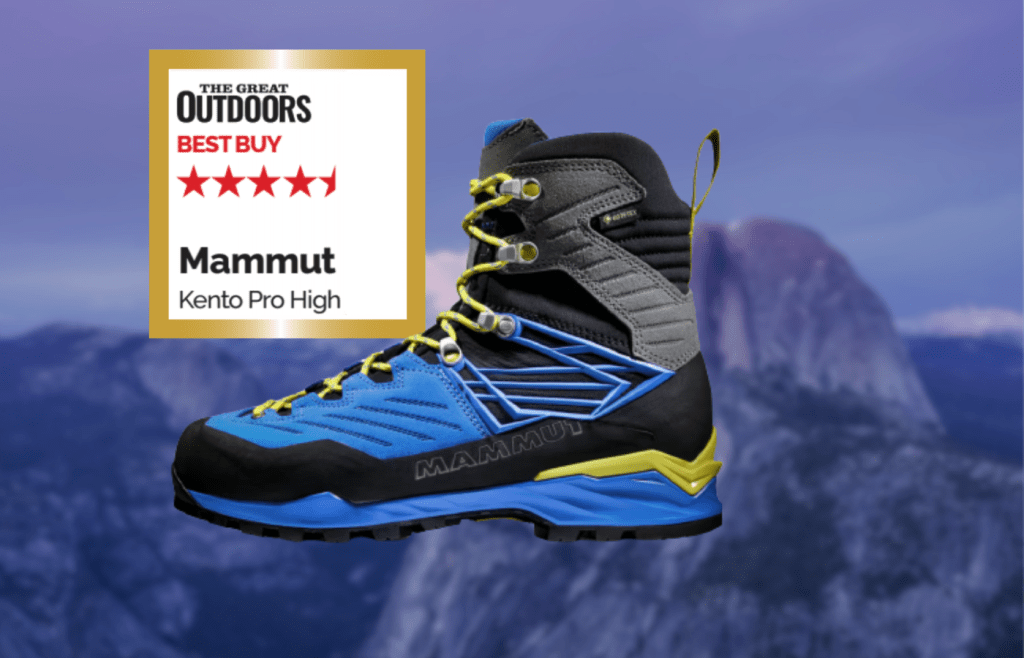
SQUIRREL_BUTTON_3948010
- Rating: 4.5/5
- RRP: £290
- Weight: 1320g (EU38, pair)
- Pros: Price, insulation
- Cons: Runs small, fabric lace eyelets
B rating: B2 | Waterproofing: Goretex | Upper: Velours leather | Crampon welts: Heel welt | Sole: Vibram Hexa Tech | Sizes: UK 3.5-8.5 with half sizes | Men’s version: Yes
The Mammut Kento Pro High is the only boot in this test that gives a warmth rating temperature, which is down to -20 degrees Celsuis. Between this and the 3D memo foam cushioning, it does seem to run small, and I could only wear a thin sock which still felt a bit tight, so I would definitely size up if I was getting another pair. It is well waterproofed, and the insulation is very beneficial especially when you’re standing around.
Read more: Kirsty Pallas’ full review of the Mammut Kento Pro High. This boot was also recommended by Lucy Wallace in 2021 winter tests – you can read her full verdict here.
Best Buy in 2023: Meindl Vakuum Men’s GTX (RRP: £250)
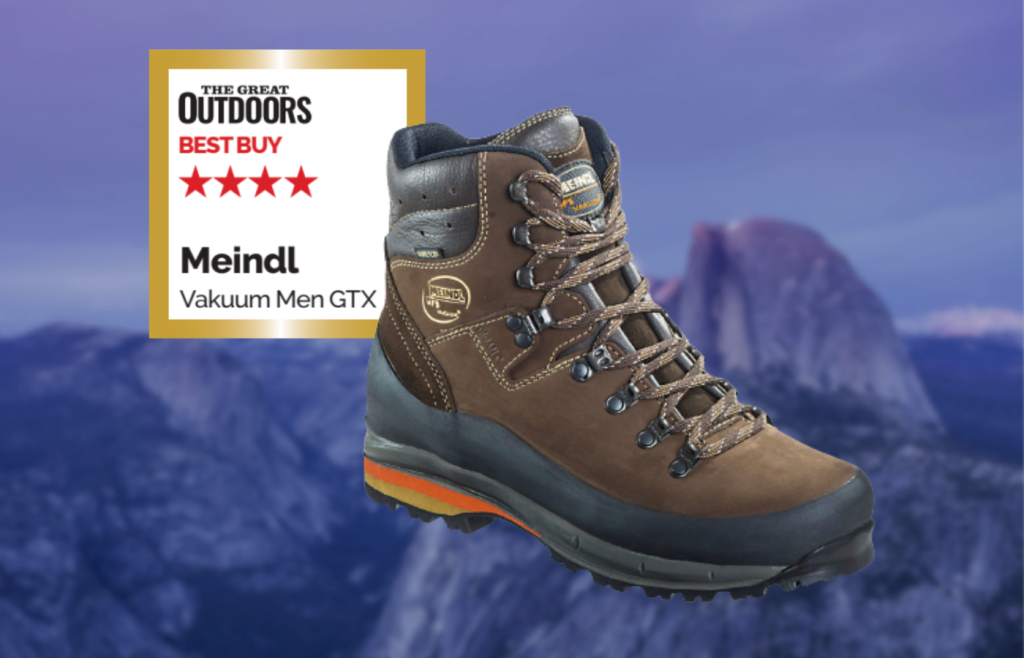
SQUIRREL_BUTTON_12991430
- Rating: 4/5
- RRP: £309.99 – £329.99, depending on size
- Weight: 1660g (EU41-2, pair)
- Pros: comfort, grip, wide range of outdoor use
- Cons: not as stiff soled as some winter boots
B rating: B1 equivalent | Waterproofing: Gore Tex waterproof lining | Upper: nubuck leather upper, rubber rand | Crampon welts: none | Sole: Meindl Multigriff 2 by Vibram | Sizes: EU39-49 with half sizes up to 46 | Woman’s version: yes
Straight out of the box, the Meindl Vakuum Men GTX felt stiff. It’s the second heaviest men’s boot in the review, so I was concerned they would be a little unwieldy until broken in. An hour into their first walk, I adjusted the laces at a rest stop and realized that they had already settled into an extremely comfortable fit. We ending up adding at extra 20km walking to our day, and I had no foot issues.
Read more: Peter Macfarlane’s full review of the Meindl Vakuum Men’s GTX.
BEST BUY in 2023: Lowa Cevedale Evo Women’s GTX (RRP: £275)
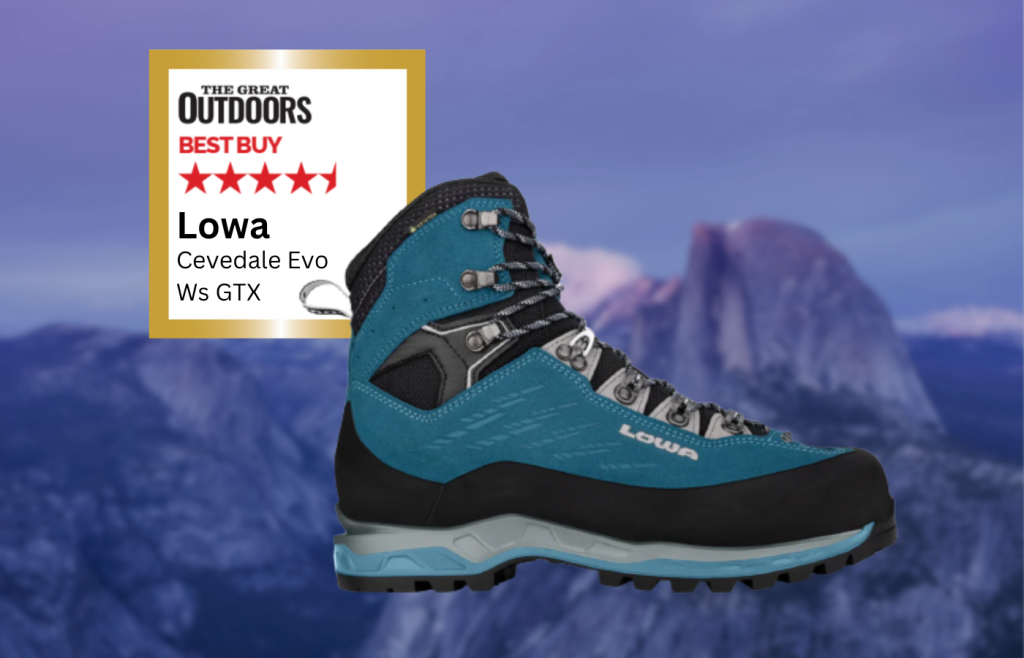
- Rating: 4.5/5
- RRP: £275
- Likes: build quality, toughness
- Dislikes: none
- Weight: 1390g (pair)
Upper: Suede, fabric | Outer Sole: Vibram Scalatore Evo | Stiffness: B2 | Sizes: 4-9
I’m familiar with the predecessor to this boot having used it in winter for a couple of years and it has lasted well. These are the widest of the boots I tested and, although they are the same size as my old pair, I found them to be slightly shorter, so if you are looking to replace an old pair with the new version, it is worth trying them on first.
Read more: Lucy Wallace’s Lowa Cevedale Evo GTX Ws full review
Best Buy in 2021: Lowa Alpine Pro GTX (RRP: £250)
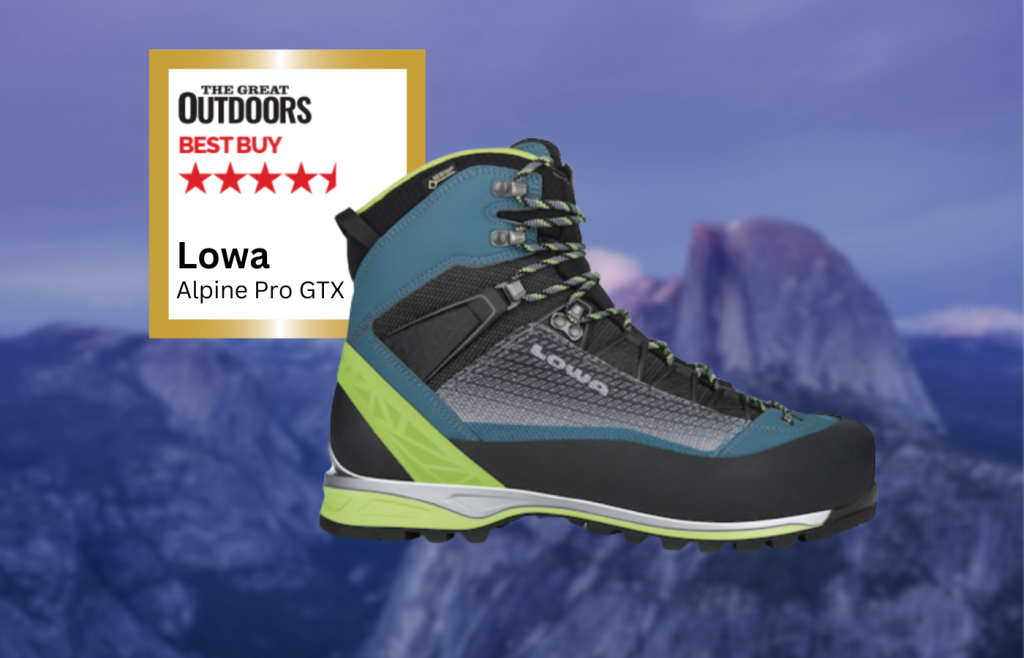
- Rating: 4.5/5
- RRP: £250
- Likes: reduced price, grip, lacing
- Dislikes: nothing
- Weight: 860g
Upper: suede and synthetic | Outer: sole Vibram Alp Trac | Stiffness: B2 | Sizes 8-12
As the name suggests, this is an alpine boot, but brought up to date. Stiffness is at the lower end of B2 and as such there’s enough flex in the toe to make walking more comfortable, but enough stiffness in the sole to provide a good platform for crampons and to allow edging on snow and ice. The Vibram sole provides excellent traction, even on rimed up rock.
Read more: David Lintern’s Lowa Alpine Pro GTX review
Recommended in 2023: Scarpa Manta Tech
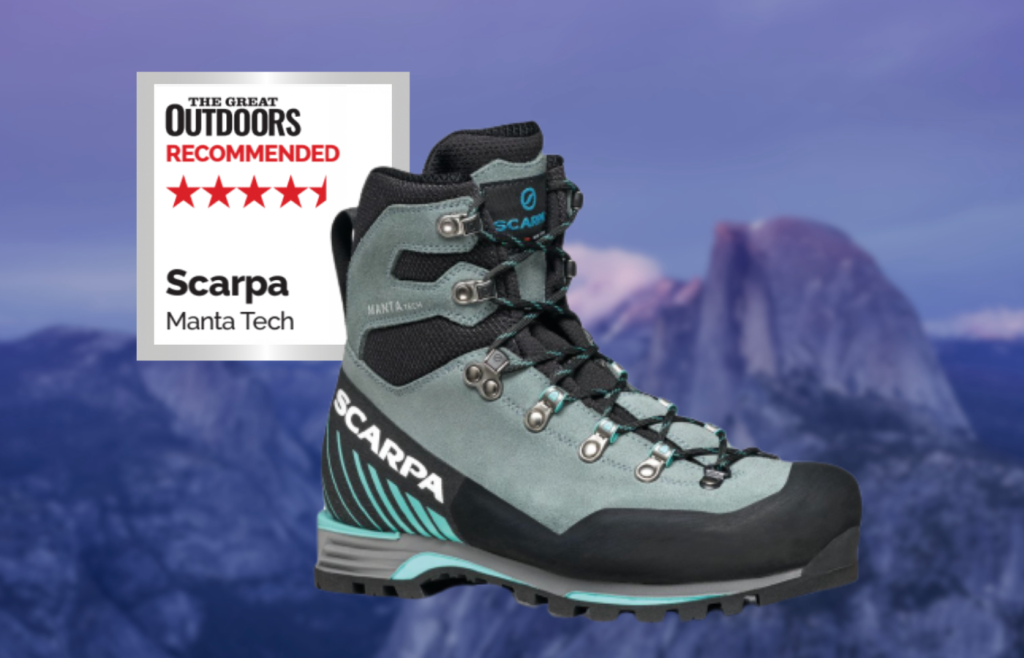
SQUIRREL_BUTTON_12991408
- Rating: 4.5/5
- RRP: £350
- Weight: 1285g (EU 38, pair)
- Pros: Weight, comfortable fit
- Cons: Price, pressure on top of foot
B rating: B2 | Waterproofing: Goretex Insulated Comfort | Upper: 3mm Suede Perwanger | Crampon welts: Heel welt | Sole: Vibram Pentax Precision XT | Sizes: EU 36-42 with half sizes | Men’s version: Yes
The Scarpa Manta is a classic B2 winter boot, often used for hire because of their reliability and sturdiness. The newer Manta Tech is an equally solid and comfortable option but weighs less than its predecessor.
Read more: Kirsty Pallas’ full review of the Scarpa Manta Tech. David Lintern also recommended the Scarpa Manta Tech in his 2021 reviews. You can read his verdict here.
Recommended in 2023: Salewa Ortles Ascent Mid

- Rating: 4/5
- RRP: £340
- Weight: 1432g (EU38, pair)
- Pros: Comfortable ankle collar, solid sole unit
- Cons: Debris gaiter not high enough, no lace lock at ankle
B rating: B2 | Waterproofing: Goretex Insulated Comfort | Upper: 2mm Suede | Crampon welts: Heel welt | Sole: Vibram Alpine Guide | Sizes: EU35-42 with half sizes | Men’s version: Yes
The Salewa Ortles Ascent Mid is an attractive boot, with good warmth and comfort, but with a few features that I don’t think work quite as well as they could. The suede upper with Goretex membrane is waterproof and comfortable to wear without any breaking in, even for a wide forefoot, despite not looking particularly wide. The ankle collar is soft and flexible at the back to make descending feel comfortable, but supportive at the sides for ankle protection. It’s the only boot in my selection where the tongue is a separate unit from the main boot, which does mean it can move around more independently.
Read more: Peter Macfarlanes’ full review of the Salewa Ortles Ascent Mid boot.
Recommended in 2023: AKU Trekker Therm200
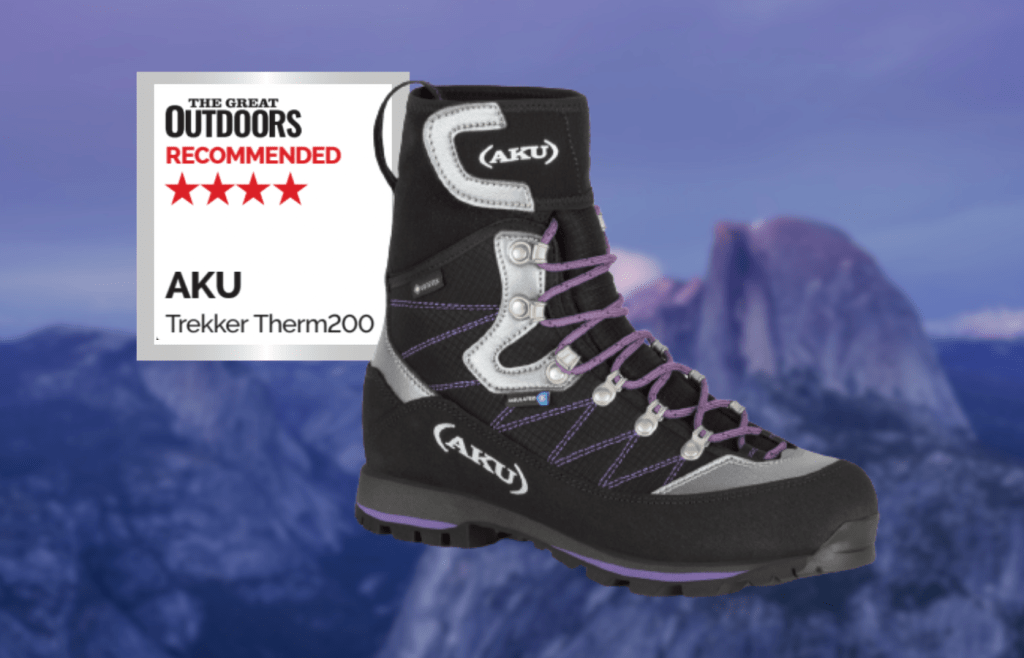
The AKU Trekker Therm200 is a brand new boot from AKU, and is the only boot in this test that is not officially B rated. This is very noticeable in the weight – they are extremely light as there’s no shank in the midsole, and alongside a synthetic upper they feel like clouds on your feet! They are designed to be worn with snowshoes but will take a flexible C1 crampon (with both front and heel baskets), although AKU only recommends this for limited use.
- Rating: 4/5
- RRP: £245
- Weight: 984g (EU38, pair)
- Pros: Weight, sole flex when walking
- Cons: Not B rated, lace durability
B rating: None | Waterproofing: Goretex insulated comfort | Upper: AKU Air8000 | Crampon welts: None | Sole: Vibram Curcuma | Sizes: EU35-42 with half sizes | Men’s version: Yes
They are comfortable straight out of the box, and feel easy to slip into, helped by the loop on the back and the tongue for pulling on the boot. The padded ankle collar doesn’t come up very high, which gives lots of flexibility, but there is an additional elastic debris gaiter to add height. This is fixed with Velcro in the front above the laces and can be adjusted to suit your calf. The tongue is attached to the boot with a loop for adjusting placement and pulling it up to stop any wrinkling.
Read more: Kirsty Pallas’ full review of the AKU Trekker Therm200.
Recommended in 2023: Altberg Mallerstang Mountain Boot
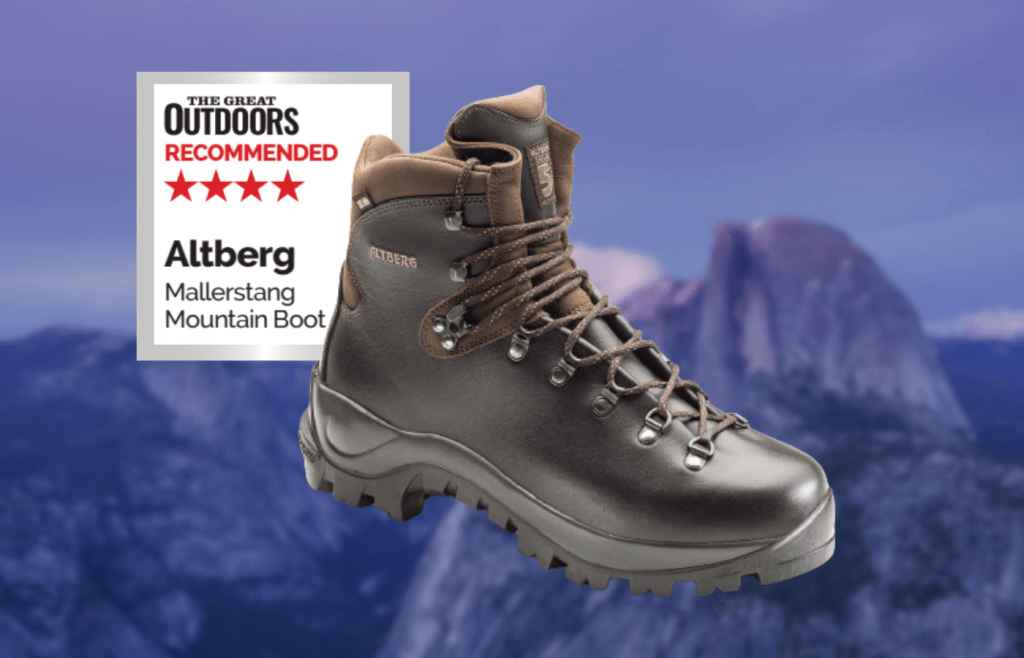
The Altberg Mallerstang Mountain Boot is a traditional mountain boot in looks and construction. The upper is 2.8mm thick leather which is tough and durable but which also makes the boot very stiff to wear initially. It was the only boot in my selection that I had to break in at home, before trying some short walks and only then taking them into the hills.
- Rating: 4/5
- RRP: £264
- Weight: 1820g (EU41-2, pair)
- Pros: durability, reproofable upper, resoleable, grip, fit options
- Cons: initial breaking in, weight
B rating: B2 | Waterproofing: Sympatex waterproof lining | Upper: 2.8mm one piece Anfibio leather | Crampon welts: Heel welt | Sole: Vibram Ice Trek | Sizes: EU38-48 including half sizes and 5 width fittings | Woman’s version: Unisex design
Read more: Peter Macfarlane’s full review of the Altberg Mallerstang Mountain Boot.
Recommended in 2023: Hanwag Ferrata II GTX
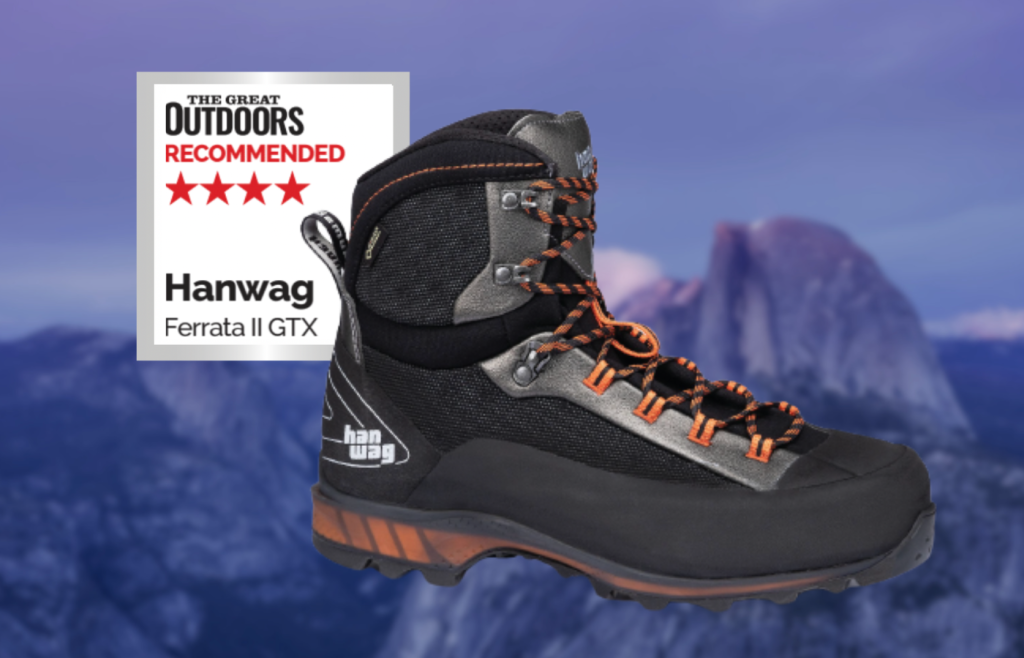
SQUIRREL_BUTTON_12991451
- Rating: 4/5
- RRP: £335
- Weight: 1550g (EU41-2, pair)
- Pros: light, grippy, dexterous
- Cons: price
B rating: B2 equivalent | Waterproofing: Gore-Tex waterproof lining | Upper: synthetic, microfiber, rubber overlay | Crampon welts: heel welt | Sole: Vibram Climbing Zone | Sizes: EU39-47 including half sizes | Women’s version: yes
The Hanwag Ferrata II GTX has the look of a rigid alpine climbing boot but has a very different feel, both on the foot and in its range of uses. The upper is a mix of synthetic materials, some with a leather feel and some have a woven texture. Different weights of these materials are used to create alternating areas of strength or flexibility which means the Ferrata was comfortable straight from the box with no breaking in. Ankle movement in the upper was immediately natural and I could wear them on a shorter hill day straight away.
Read more: Peter Macfarlane’s full review of the Hanwag Ferrata II GTX.
Recommended in 2023: Keen Revel IV High Polar Boot
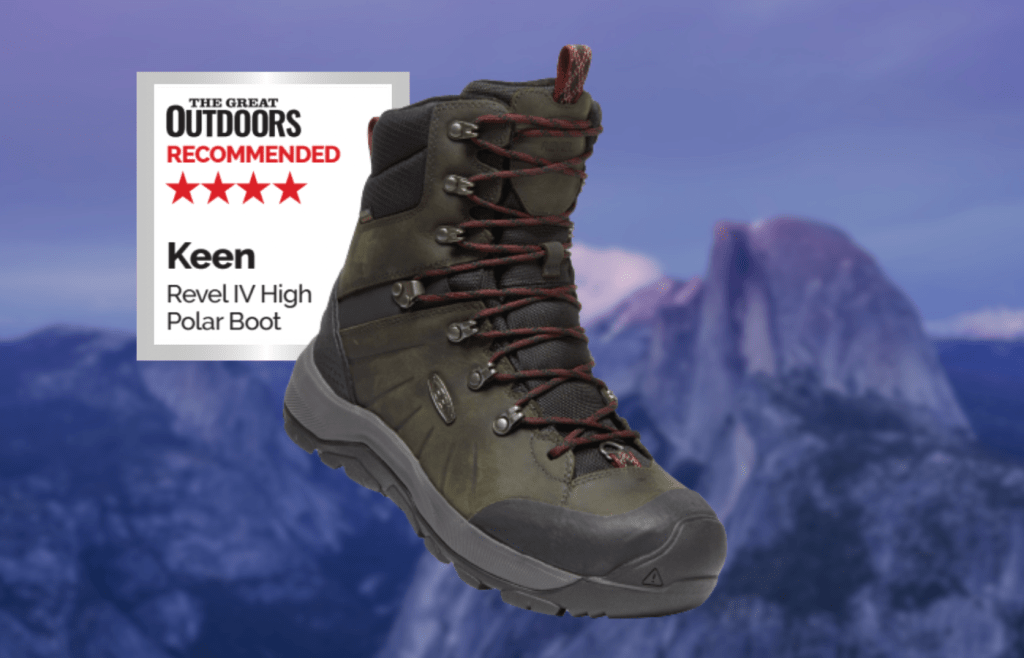
SQUIRREL_BUTTON_12991466
- Rating: 4/5
- RRP: £165
- Weight: 1550g (EU41-2, pair)
- Pros: weight, comfort, range of winter use
- Cons: not stiff enough for tradition winter walking or crampons
B rating: B0 | Waterproofing: KEEN.DRY waterproof lining | Upper: leather and mesh upper with recycled PET insulation | Crampon welts: none | Sole: Kenn.Polar Traction | Sizes: EU40-49 with half sizes up to 45 | Women’s version: yes
Keen have always taken a different approach to the design of their outdoor winter boots with flexibility and warmth being the priority. Any thoughts of crampon compatibility is up to you, the user, to work out. Lightweight flexible crampons suit winter Keens very well but the boots’ use in the winter hills can take a little adapting to. This is the case with the Keen Revel IV High Polar Boot.
Read more: Peter Macfarlane’s full review of the Keen Revel IV High Polar.
Recommended in 2021: Hanwang Makra Combi GTX (RRP: £245)
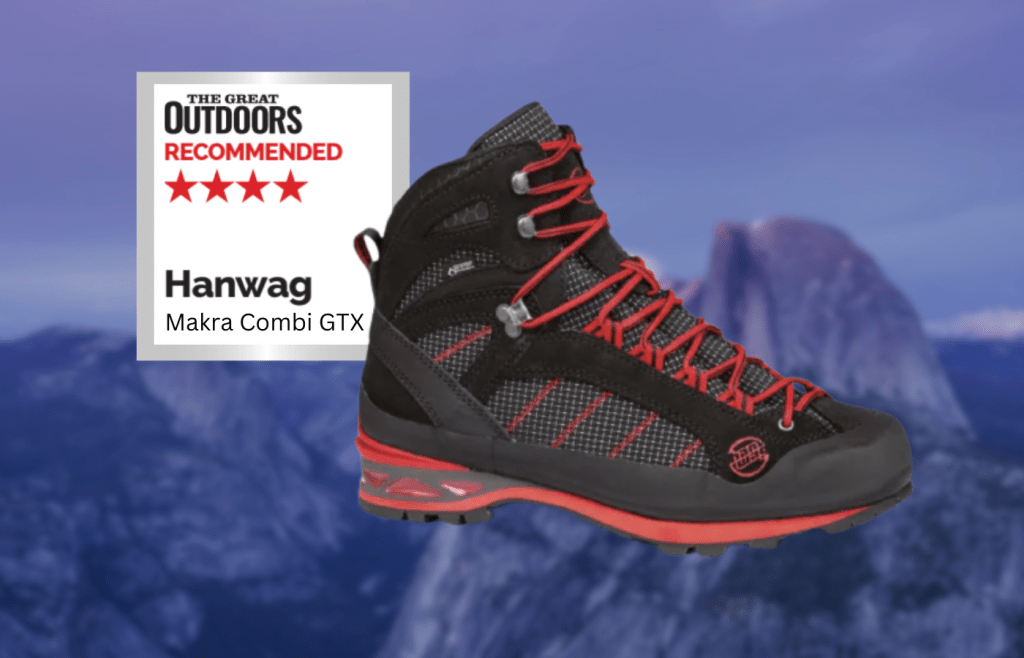
- Rating: 4/5
- Likes: weight, fit, adaptability
- Dislikes: rocker
Weight: 730g | Upper: Suede, Cordura | Outer sole: Vibram Pepe | Stiffness: B2 | Sizes 6-13
The Makra is a smart looking, ultra-modern offering, and a honeycomb structure in the sole and modern synthetic upper means it’s the lightest boot in my test.
Read more: David Lintern’s full review of the Hanwang Makra Combi GTX review
Recommended in 2021: AKU Tengu GTX (RRP £294.99)
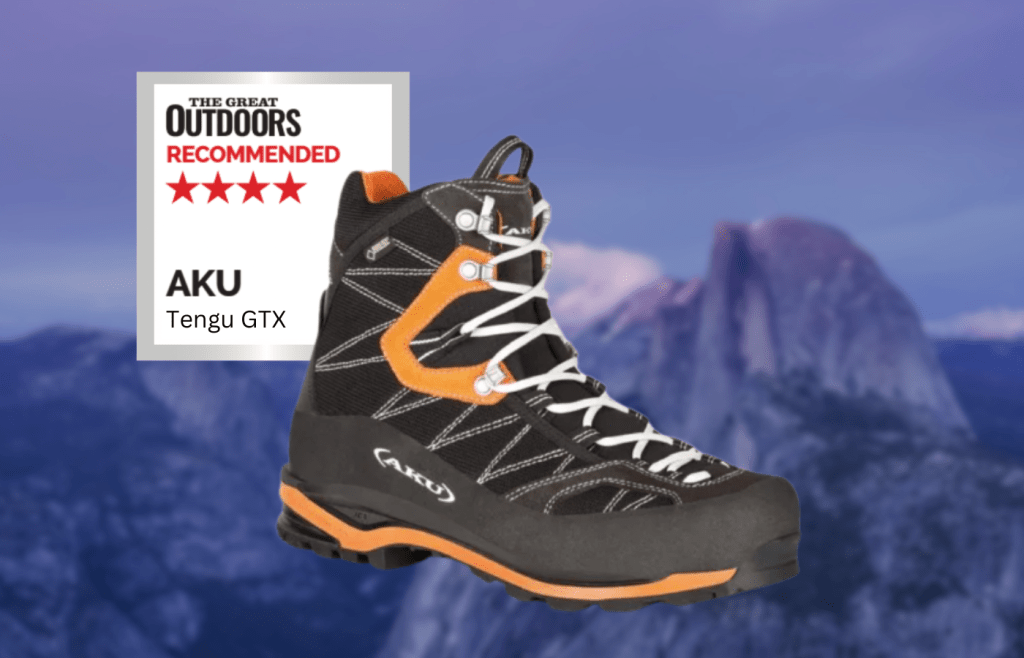
- Rating: 4/5
- Likes: grip, lacing
- Dislikes: fit
Weight: 880g | Upper: nylon and suede | Outer sole: Vibram Curcuma | Stiffness: B2 | Sizes 4.5-12
This is the most climbing-focused boot in the test. Sole stiffness is ‘classic B2’, with a slight flex in the forefoot and very stiff laterally. The fit is ‘Italian’; on the longer, narrower side. It’s especially narrow at the toe, with a lower volume internally than others here. In practice for me this means a little toe scrunch on descent, but total confidence on ascent.
Read more: David Lintern’s full review of the Aku Tengu GTX review
Recommended in 2021: Meindl Litepeak Pro GTX (RRP: £260)
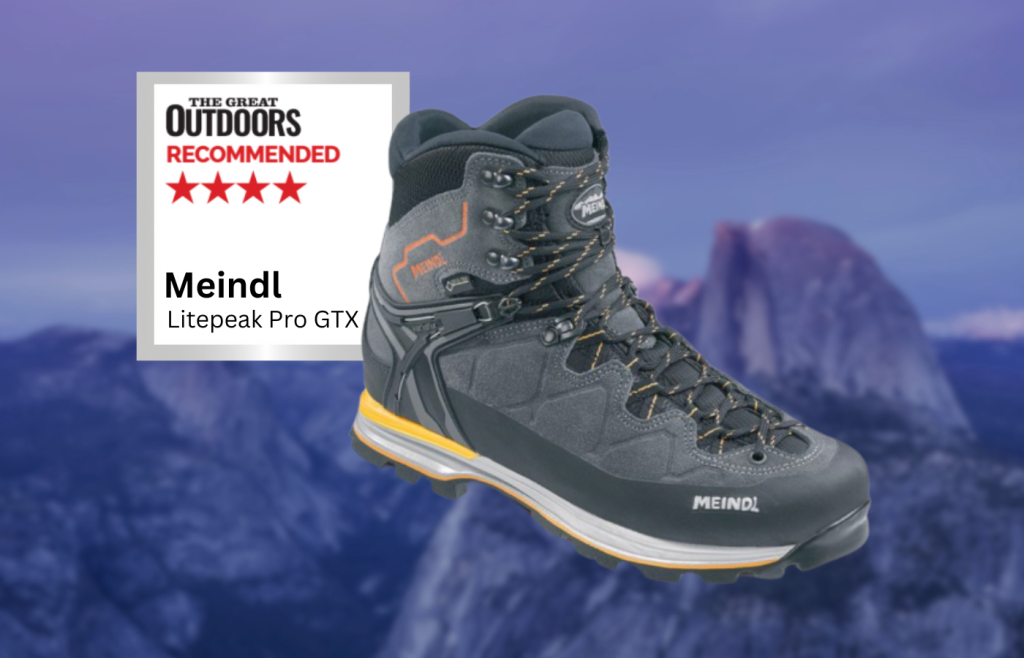
- Rating: 4/5
- Likes: relaxed fit, adaptability
- Dislikes: stiff ankle cuff
Weight: 890g | Upper: Suede and mesh | Outer sole: Vibram Alpin | Stiffness: B1 | Sizes: 6-12
The Litepeak is the only B1 boot in my selection. As such it’s a bit of an odd one out, but that’s not a criticism. In some ways this is a perfect hybrid of traditional 3 and 4 season footwear.
Read more: David Lintern’s full review of the Meindl Litepeak Pro GTX review
Recommended in 2021: Salewa Raven 3 Ws GTX (RRP: £270)
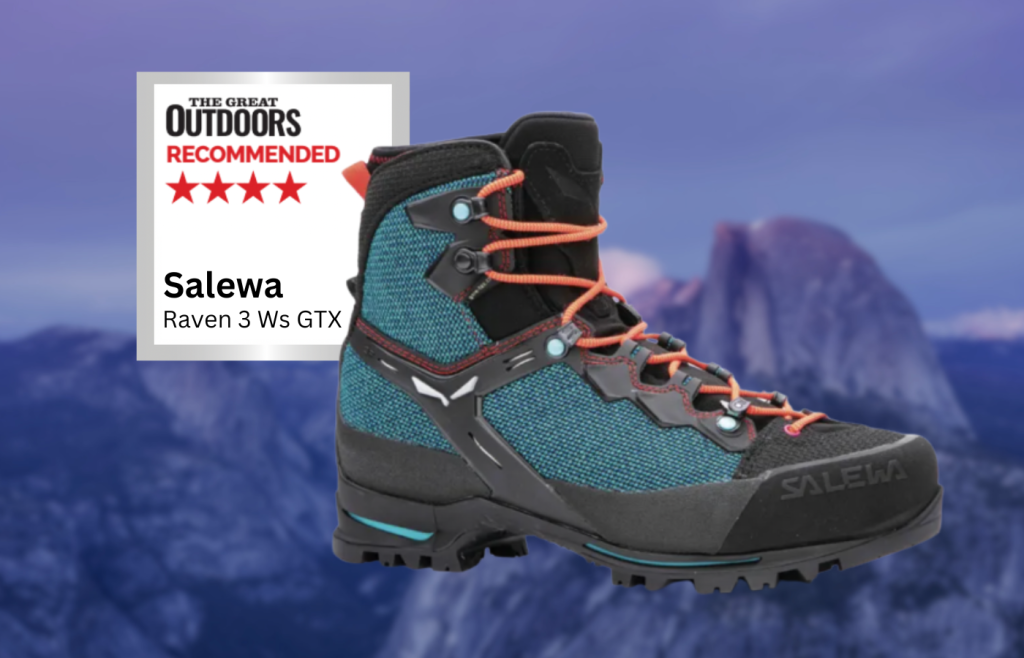
- Rating: 4/5
- Likes: comfort, lacing system
- Dislikes: low rand, fussy sole design
Weight: 629g per boot | Upper: abrasion resistant fabric | Outer Sole: Vibram WTC | Stiffness: B2 | Sizes: 3-9
I’ve never tried Salewa boots before but having heard good things I was intrigued to give these a go. These are quite narrow, and snug from heel to toe, whilst being true to size in length, prompting me to wear a thinner sock than I normally would in winter.
Read more: Lucy Wallace’s full review of the Salewa Raven 3 Ws GTX review
Features to look for in the best mountaineering boots
Fit
Winter boots are quite stiff and fit is important. Try them on with an experienced boot fitter to hand. Lots of heel lift is bad, but toes need wiggle room. Tight boots can cause frostbite, but you don’t want your foot sliding forward when kicking steps.
Last
The “last” is a mould around which a boot is constructed. Lasts vary in shape and volume- as do human feet- and different brands use different shapes. Look out for variation in the size and shape of toe box and heel cup as well as overall width.
Uppers
Modern winter boots are often a composite mix of leather and synthetic materials, with trade-off between weight, warmth and durability.
Rand
A rubber rand covers the point where the uppers meet the sole, which adds durability. This is important for protecting the boot when kicking in to hard snow and scrambling on rock.
Lacing
Look out for locking cleats, and free running cleats that allow one section to be cinched in tight, and another to be slackened off. Typically, a looser fit is more comfortable on the approach, but once crampons are on everything needs to be snug.
Waterproof Membrane
A waterproof membrane is vital, to keep the feet dry and prevent frostbite. Gore-Tex is the most frequently used, in the form of sock-like insert. The Scarpa boot in the women’s test uses a membrane that is laminated directly to the uppers.
Weight
Boots designed for winter mountaineering tend to be heavier than their summer counterparts, (typically 2kg a pair), but increasingly, lightweight models are available. Bear in mind that there may be a compromise in warmth or durability to keep the weight low.
Stiffness
Winter mountaineering boots are stiff to make it easier to fit crampons, and to improve the efficiency of kicking in to compact and refrozen snow.
Edges
The sole has a tread that is designed to shed snow, and the edges of the sole are neat and defined, useful for slicing the foot into snow to kick out footsteps.
Crampon Compatibility
B1 Boots are the most flexible of winter specific boots and compatible with C1 crampons only – that have a basket at the front and back. It is possible to attach crampons to flexible footwear, but the more flexible the boot, the greater the likelihood of crampons becoming detached on steep ground. C1 crampons are fine for most UK hillwalking.
B2 Boots are compatible with C2 crampons (with a basket at the front, and a heel clip lever at the back). C2 crampons are well suited to both challenging winter mountain walking and ‘graded’ ground which involves a level of technicality (e.g. many popular scrambles in winter conditions). They are less fiddly to put on and have more spikes than C1, but require quite a stiff boot, with a ledge at the back for the lever to rest on. B2 boots can be worn with C1 or C2 crampons, but not C3 crampons.
B3 boots do not flex, have ledges at toe and heel, and are compatible with C3 crampons. These rigid, aggressive crampons are designed for winter / ice climbing and technical mountaineering and as such are overkill for hillwalking.

